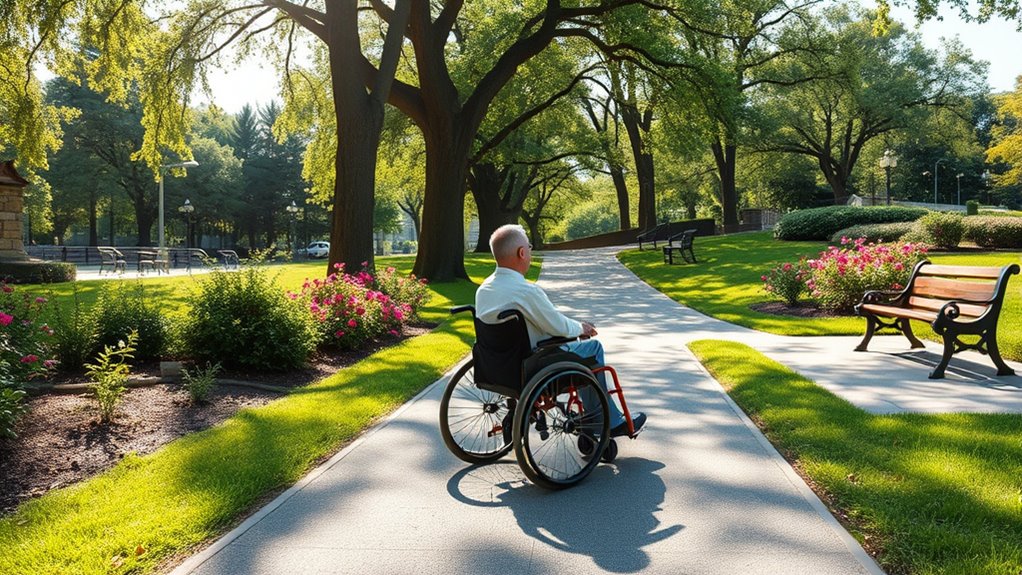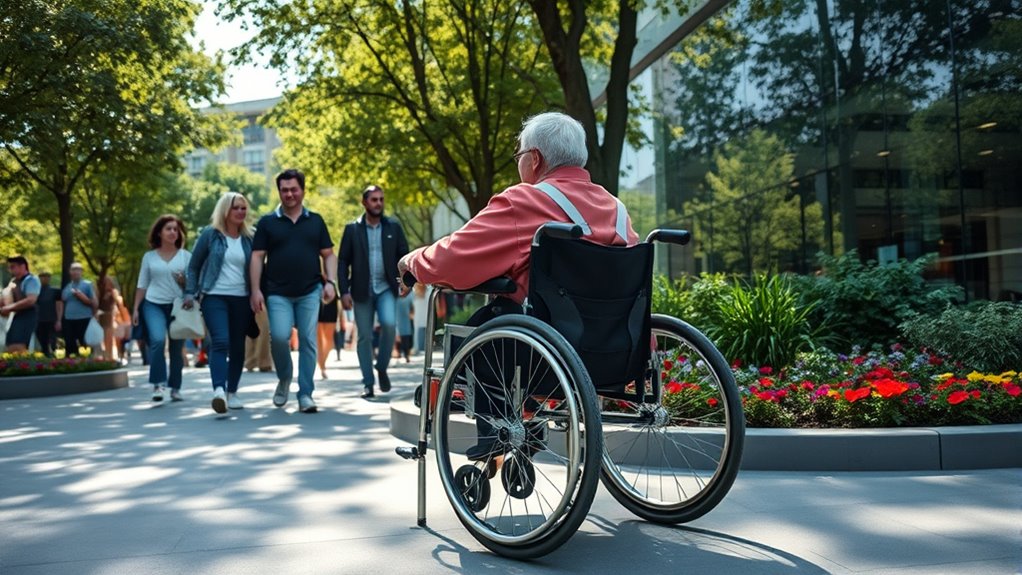To navigate public spaces with mobility limitations confidently, rely on accessible designs like curb cuts, wide pathways, and smooth flooring. Use assistive devices such as motorized wheelchairs or smart navigation apps that guide you through accessible routes and facilities. Public transportation with low-floor buses and tactile cues also ease your journey. By exploring these options, you’ll find ways to move more freely and independently. Keep exploring to discover how inclusive environments can further enhance your experience.
Key Takeaways
- Utilize assistive devices like wheelchairs, scooters, and canes for enhanced mobility in public spaces.
- Rely on accessible design features such as curb cuts, wide doorways, and smooth flooring to navigate comfortably.
- Use smart navigation apps that provide accessible routes, real-time guidance, and facility information.
- Seek public transportation options equipped with low-floor buses and accessible stations for easier travel.
- Advocate for inclusive infrastructure improvements to reduce barriers and promote independence in community environments.

Finding your way through public spaces can be a challenge for those with mobility limitations, especially when facilities are not designed with accessibility in mind. Fortunately, advances in assistive technology and accessible design are transforming how you navigate your surroundings. These tools and layouts aim to remove barriers, making everyday activities more manageable and inclusive. When public spaces incorporate accessible design principles, they create environments that accommodate a wide range of mobility needs, allowing you to move independently and confidently.
Assistive technology plays a significant role in enhancing mobility and independence. Devices such as motorized wheelchairs, scooters, and mobility aids like canes or walkers are tailored to support your specific needs. Modern assistive devices often feature lightweight materials, rechargeable batteries, and user-friendly controls, making them easier to operate and transport. For example, portable ramps and stairlifts provide solutions for overcoming elevation changes, while smart navigation apps can guide you through unfamiliar environments, pinpointing accessible routes and facilities. These technologies empower you to participate fully in public life, reducing reliance on others and increasing your confidence.
Assistive devices like wheelchairs, scooters, and navigation apps enhance mobility and independence for all.
Accessible design is equally vital in shaping inclusive public spaces. Architects and urban planners now prioritize features like curb cuts, wide doorways, and smooth, non-slip flooring. Such elements ensure that you can move smoothly through different areas without obstacles. Public transportation systems are increasingly equipped with low-floor buses, accessible stations, and tactile paving for visually impaired users. By integrating these design elements, spaces become more welcoming and functional. You’ll also find that clear signage, contrasting colors, and auditory cues are part of accessible design strategies that help you navigate safely. These features reduce confusion and help you locate essential services quickly. When public spaces are thoughtfully designed with these considerations, you experience less frustration and greater independence. The combination of assistive technology and accessible design doesn’t just help you get around; it promotes a sense of belonging and participation in your community.
Ultimately, the goal of accessible design and assistive technology is to make your environment adaptable to your needs, not the other way around. By leveraging these innovations, you gain more control over your mobility and are better equipped to enjoy public spaces without unnecessary barriers. This shift towards inclusivity benefits everyone, creating communities where mobility limitations don’t define your ability to explore, connect, or thrive. Designing inclusive environments ensures that everyone can participate fully in society.
Frequently Asked Questions
How Can I Find Accessible Parking Spots Nearby?
To find accessible parking spots nearby, start with parking tips like looking for designated handicap spots marked with the wheelchair symbol. Use map resources such as parking apps or websites to locate these spaces easily. Many city or venue websites also provide detailed parking information, including accessibility features. Planning ahead helps you save time and guarantees you find a convenient, accessible spot to begin your journey comfortably.
What Are My Rights When Encountering Inaccessible Public Facilities?
You have the right to accessible facilities under disability rights and legal protections like the ADA. If you encounter inaccessible public spaces, you can request reasonable accommodations or file a complaint with relevant authorities. These laws protect you from discrimination and guarantee equal access. Always document issues and know your rights, so you can advocate for yourself confidently and seek enforcement when necessary.
How Do I Communicate My Needs Effectively in Unfamiliar Places?
Ever wonder how to make your needs clear in unfamiliar places? Start by pointing out accessible signage or using assistive technology to communicate your requirements. Clearly state what you require, whether it’s an accessible entrance, seating, or assistance. Be confident and polite, and don’t hesitate to ask staff for help. Using these tools and approaches guarantees your needs are understood and met efficiently, making your experience smoother and more comfortable.
Are There Mobile Apps That Assist With Navigation for Mobility Limitations?
Yes, there are assistive technology navigation apps designed for mobility limitations. Apps like Wheelmap and AccessNow help you find accessible routes, ramps, and elevators. You can also use Google Maps, which offers wheelchair-friendly options in many areas. These navigation apps provide real-time information, making it easier to plan your route and avoid obstacles. Downloading and customizing these apps guarantees you have reliable assistance whenever you explore unfamiliar public spaces.
How Can I Advocate for Better Accessibility in My Community?
You can advocate for better accessibility by engaging your community, empowering your voice, and influencing policy change. Organize meetings, join local advocacy groups, and share your experiences to raise awareness. Push for policy advocacy that enforces accessible infrastructure, ramps, and transportation. Collaborate with neighbors, businesses, and officials to create a united front. Your persistent efforts can transform community spaces into inclusive environments where everyone can move freely and confidently.
Conclusion
Navigating public spaces with mobility limitations can be challenging, but with accessible infrastructure and understanding communities, it becomes easier. You might worry that accommodations slow everyone down, but they actually create a more inclusive environment for all. By advocating for improvements and being patient, you help foster a society where everyone can move freely and confidently. Remember, accessibility benefits everyone—it’s about creating spaces where no one is left behind.









